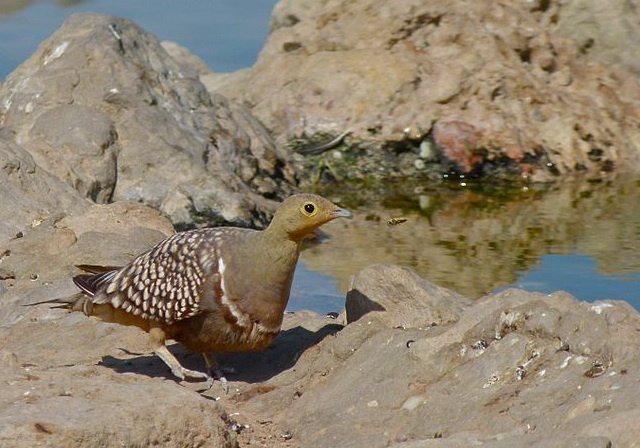Namaqua sandgrouse father carries water for the chicks
As long as the chicks are unable to fly, a Namaqua sandgrouse father will fetch water for them. Jochen Mueller and Lorna Gibson describe the specially adapted belly feathers that enable this.
As their name suggests, sandgrouse species live in dry, almost barren places. The Namaqua sandgrouse (Pterocles namaqua), for example, lives in deserts in Southwest Africa, such as the Kalahari and the Namibian desert. The birds breed up to no less than 30 kilometers from the nearest body of water. Because they mainly eat dry seeds, they have to drink. Adult birds therefore fly to waterholes in the morning and evening. This is how they survive in their arid habitat.
But their chicks can’t go with them to the waterholes for the first month. They are immediately independent after hatching; they walk and forage for food on their own. But they can’t fly yet. It was already known that sandgrouse fathers transport a supply of water for the young in specially adapted belly feathers, which trap and hold water. Now, using various microscopic techniques, Jochen Mueller and Lorna Gibson describe the structure of those feathers in detail, both in wet and dry state.
Fringe
To stock up a supply of water, a Namaqua sandgrouse male steps into the water until it reaches his belly. He fluffs up his belly feathers and rocks his body, soaking the feathers. Then, he presses his belly feathers against his body and leaves. He can store an estimated 25 milliliters of water, 15 percent of his body weight. He flies back at high speed, a trip that can take half an hour. During the flight through dry desert air, some water evaporates, but a lot is still left when he arrives at his nest.
The chicks run up to him and strip the wet feathers with their beaks.
That the belly feathers have a special structure, can already be seen with the naked eye. The feathers have a broad hairy fringe along the side, except at the top. But only under the microscope does the special structure reveal itself completely.
Coiled barbules
A normal bird’s contour feather consists of a shaft on which barbs are implanted, from which barbules branch. These barbules interlock with hooklets and grooves, giving the feather a closed plane. Thanks to the hooklets and grooves, a crumpled feather can be rubbed back into shape.
Under the microscope, the barbs and barbules of the belly feathers of Namaqua sandgrouse males appear to have a different structure. The hairy fringe along the feather is formed by the outer part of the barbs being thin and flexible, and the barbules implanted on the outer part being thin and flexible too.
The inner part of the barbs, where they are attached to the shaft up to just over mid-length, is thicker and stiff. The barbules on this part branch at the upper side, make one helical curl downward and straighten out, running parallel to the barb. The coils of successive barbules intertwine and keep the feather surface closed.
That is how a belly feather looks when it is dry.
Storing water
If such feather gets wet, the picture changes. The barbules on the inner part of the barb uncurl and bend downwards perpendicularly to the feather plane, forming a dense forest of fibers. Due to the so-called capillary force, water is sucked up and held between them.
The fringe of the feather (i.e., the outer parts of the barbs and the barbules that branch from those parts) bends down and inward to the feather shaft, creating a layer to hold the water.
The Namaqua sandgrouse is one of 14 species of sandgrouse (Pterocles), all of which live on arid terrain. In all these species, the males can carry water in their belly feathers, thanks to that unique adaptation of the feather structure.
Willy van Strien
Photo: Pterocles namaqua, male. Bernard DUPONT (Wikimedia Commons, Creative Commons CC BY-SA 2.0)
On YouTube: Namaqua sandgrouse male fetches water for chicks
Sources:
Mueller, J. & L.J. Gibson, 2023. Structure and mechanics of water-holding feathers of Namaqua sandgrouse (Pterocles namaqua). Journal of the Royal Society Interface 20: 20220878. Doi: 10.1098/rsif.2022.0878
Cade, T.J. & G.L. Maclean, 1967. Transport of water by adult sandgrouse to their young. The Condor 69: 323-343. Doi: 10.2307/1366197
